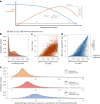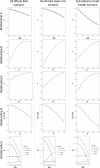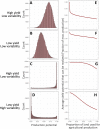Biodiversity-production feedback effects lead to intensification traps in agricultural landscapes
- PMID: 38448509
- PMCID: PMC11009109
- DOI: 10.1038/s41559-024-02349-0
Biodiversity-production feedback effects lead to intensification traps in agricultural landscapes
Abstract
Intensive agriculture with high reliance on pesticides and fertilizers constitutes a major strategy for 'feeding the world'. However, such conventional intensification is linked to diminishing returns and can result in 'intensification traps'-production declines triggered by the negative feedback of biodiversity loss at high input levels. Here we developed a novel framework that accounts for biodiversity feedback on crop yields to evaluate the risk and magnitude of intensification traps. Simulations grounded in systematic literature reviews showed that intensification traps emerge in most landscape types, but to a lesser extent in major cereal production systems. Furthermore, small reductions in maximal production (5-10%) could be frequently transmitted into substantial biodiversity gains, resulting in small-loss large-gain trade-offs prevailing across landscape types. However, sensitivity analyses revealed a strong context dependence of trap emergence, inducing substantial uncertainty in the identification of optimal management at the field scale. Hence, we recommend the development of case-specific safety margins for intensification preventing double losses in biodiversity and food security associated with intensification traps.
© 2024. The Author(s).
Conflict of interest statement
The authors declare no competing interests.
Figures










Similar articles
-
Conventional land-use intensification reduces species richness and increases production: A global meta-analysis.Glob Chang Biol. 2019 Jun;25(6):1941-1956. doi: 10.1111/gcb.14606. Epub 2019 Apr 9. Glob Chang Biol. 2019. PMID: 30964578
-
Pasture intensification is insufficient to relieve pressure on conservation priority areas in open agricultural markets.Glob Chang Biol. 2018 Jul;24(7):3199-3213. doi: 10.1111/gcb.14272. Epub 2018 May 4. Glob Chang Biol. 2018. PMID: 29665157
-
Aligning biodiversity conservation and agricultural production in heterogeneous landscapes.Ecol Appl. 2020 Apr;30(3):e02057. doi: 10.1002/eap.2057. Epub 2020 Jan 10. Ecol Appl. 2020. PMID: 31837241
-
Ecological intensification and diversification approaches to maintain biodiversity, ecosystem services and food production in a changing world.Emerg Top Life Sci. 2020 Sep 8;4(2):229-240. doi: 10.1042/ETLS20190205. Emerg Top Life Sci. 2020. PMID: 32886114 Free PMC article. Review.
-
Assessing the impacts of agricultural intensification on biodiversity: a British perspective.Philos Trans R Soc Lond B Biol Sci. 2008 Feb 27;363(1492):777-87. doi: 10.1098/rstb.2007.2183. Philos Trans R Soc Lond B Biol Sci. 2008. PMID: 17785274 Free PMC article. Review.
Cited by
-
From marginal croplands to natural habitats: A methodological framework for assessing the restoration potential to enhance wild-bee pollination in agricultural landscapes.Landsc Ecol. 2024;39(11):194. doi: 10.1007/s10980-024-01993-y. Epub 2024 Nov 12. Landsc Ecol. 2024. PMID: 39539641 Free PMC article.
-
Lessons from Ethiopian coffee landscapes for global conservation in a post-wild world.Commun Biol. 2024 Jun 10;7(1):714. doi: 10.1038/s42003-024-06381-5. Commun Biol. 2024. PMID: 38858451 Free PMC article. Review.
-
Are agricultural commodity production systems at risk from local biodiversity loss?Biol Lett. 2024 Sep;20(9):20240283. doi: 10.1098/rsbl.2024.0283. Epub 2024 Sep 18. Biol Lett. 2024. PMID: 39288815 Free PMC article. Review.
-
Different active exogenous carbons improve the yield and quality of roses by shaping different bacterial communities.Front Microbiol. 2025 Mar 28;16:1558322. doi: 10.3389/fmicb.2025.1558322. eCollection 2025. Front Microbiol. 2025. PMID: 40226102 Free PMC article.
References
MeSH terms
Substances
Grants and funding
LinkOut - more resources
Full Text Sources
Medical

